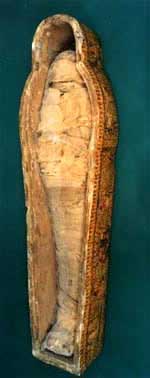Chemistry reveals mummies’ secrets

Unravelling the past: pharaonic undertakers used oils, waxes and fats. <br>© Trustees of the National Museums of Scotland. <br>
Ancient embalming not to be sniffed at.
Archaeologists thought they had mummification wrapped up. But a new analysis of ancient Egyptian embalming suggests that they have underestimated this sophisticated funerary practice.
Pharaonic undertakers used a wealth of oils, waxes and fats, say Stephen Buckley and Richard Evershed at the University of Bristol, UK. They are the first to study several mummies from different periods using modern analytical chemistry1.
“This will be an eye-opener for archaeologists and Egyptologists everywhere,” says Jaap Boon, a chemist at the FOM Institute for Atomic and Molecular Physics in Amsterdam, the Netherlands.
The ancient Egyptians guarded the techniques of mummification closely. “Its sacred nature made them very protective,” says Buckley. No written descriptions remain other than second-hand accounts by Greek and Roman historians. Information is also scant because the law protects mummies as rare historical artefacts and as human remains.
As modern chemistry requires only tiny samples, it does little damage to artefacts. “Curators all over the world should be excited about this,” says archaeologist Sarah Wisseman of the University of Illinois in Urbana-Champaign.
The variation of ingredients used may reveal important information about the ancient Egyptian economy. Just like today, the sophistication of ancient funerals went “according to their families pocket-books”, says Wisseman. And changes in embalming practices through the ages might reflect shifts in trade routes throughout the ancient world.
Hardening evidence
The duo studied 13 mummies from the XII Egyptian dynasty (1985 BC) to Roman times (30 BC onwards), when the preservation practice fell from fashion.
They found evidence of many ’drying oils’. These substances would have been liquid when applied and then self-polymerized, hardening over time. The embalmers seem to have used these oils “a bit like a ’Ronseal’ to prevent moisture from getting in,” says Buckley. This waterproof coating protected mummies from the humidity of underground tombs.
The researchers also found traces of precious plant resins. Although these probably also had a spiritual or cultural significance, they are now known to contain natural antibacterial agents. So they most likely served as preservatives, Evershed argues.
Beeswax is present only in later mummies. It may have been used more frequently as its anti-bacterial properties became appreciated, says Buckley. It might not be coincidence, he suggests, that the word for wax in the Coptic language – derived from ancient Egyptian – is ’mum’.
|
|
|
Analysis has only scratched the surface of the embalmer’s art. |
The Bristol researchers hope to convince other curators to make their mummies available for analysis. “I’m the first to admit that we’ve just begun to scratch the surface,” says Evershed.
References
- Buckley, S. A. & Evershed, R. P. Organic chemistry of embalming agents in Pharaonic and Graeco-Roman mummies. Nature, 413, 837 – 841, (2001).
- Bahn, P. G. The making of a mummy. Nature, 356, 109, (1992).
Media Contact
All latest news from the category: Life Sciences and Chemistry
Articles and reports from the Life Sciences and chemistry area deal with applied and basic research into modern biology, chemistry and human medicine.
Valuable information can be found on a range of life sciences fields including bacteriology, biochemistry, bionics, bioinformatics, biophysics, biotechnology, genetics, geobotany, human biology, marine biology, microbiology, molecular biology, cellular biology, zoology, bioinorganic chemistry, microchemistry and environmental chemistry.
Newest articles

Recovering phosphorus from sewage sludge ash
Chemical and heat treatment of sewage sludge can recover phosphorus in a process that could help address the problem of diminishing supplies of phosphorus ores. Valuable supplies of phosphorus could…

Efficient, sustainable and cost-effective hybrid energy storage system for modern power grids
EU project HyFlow: Over three years of research, the consortium of the EU project HyFlow has successfully developed a highly efficient, sustainable, and cost-effective hybrid energy storage system (HESS) that…

After 25 years, researchers uncover genetic cause of rare neurological disease
Some families call it a trial of faith. Others just call it a curse. The progressive neurological disease known as spinocerebellar ataxia 4 (SCA4) is a rare condition, but its…






















